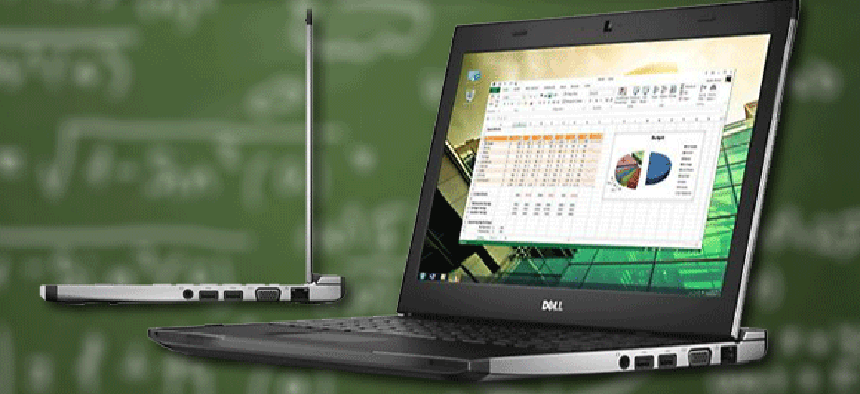Dell goes to school with new, low-priced Latitude


Connecting state and local government leaders
The 3330 isn't a powerhouse and lacks some government-style security features, but its performance, price and peripherals will fit just fine in educational settings.
Dell's Latitude line of laptops has always been known for reliability. In many previous reviews we found them to be perfect for government workers who need reliability over everything else. Latitudes have been moderately, but not overly, expensive, though that price often comes with features that government needs -- like internal security chips, smart card readers and biometric identification locks.
The downside was that the Latitudes have never been known for having the latest and greatest hardware; Dell would often hold back the newest video cards and memory sets until they had proven themselves before making them a part of the Latitude line.
The Latitude 3330 is aimed at the education market. With the 3330, Dell tries to bring good performance, portability and a lower price to institutions that may not have been able to afford a Latitude, or several hundred Latitudes, in the past. It's only really possible today because of the low cost of processors, memory and various laptop components.
Some sacrifices have been made. There is no fingerprint reader, for example. But for $539 as configured for our testing, the bang for the buck advantage can't really be overstated. As a shared laptop in an educational or training environment, it would be hard to beat the 3330. There are even education-market peripherals for the Latitude 3330, such as a lockable rolling case that can securely hold up to 30 notebooks, which allows for easy movement from classroom to classroom and provides charging ports for each device.
The Latitude 3330 weighs 3.4 pounds, yet has a 13.3-inch, 16:9 ratio widescreen display that is perfect for presentation graphics or even video display. Our test unit was actually slightly heavier, at 3.9 pounds, owing to a larger six-cell battery. It was driven by an Intel HD 3000 graphics controller, which works well enough with a native resolution of 1,366 by 768 for all but the most demanding video applications. The screen has an anti-glare coating that seemed to work great with overhead florescent lighting found in most classrooms, so that's a nice plus.
Our test unit had a 1.5GHz Intel i3-2375M processor, which can be upgraded to an i5 if for a little more power. It also had 4G of DDRL3 memory configured into four 1G slots. The hard drive was a 320G model that spun at 5,400 RPM. There was no optical drive on our test unit, though there is space for one if it’s needed.
Note the pattern: The hard drive spins at 5400, the slower of the two main speeds, and the 3330 ships with the low end i3 version of the i-line of Intel processors and the older DDR3 memory. These are all good components — the 3330 is hardly cutting corners — but it is packed with the most economical of choices it could have and still be considered a modern, reasonably fast system.
On the Passmark Performance Benchmark, the system scored 761.5. That's not a powerhouse, but good enough to run most programs found in an educational setting. The fact that it has a 64-bit operating system helped a bit, with its weakest area in terms of performance being, not surprisingly, the integrated Intel graphics controller. Unfortunately, there are no options for graphical chipsets outside of the integrated Intel family, so those who really need the power of a dedicated graphics chip will need to look elsewhere.
There were some nice extras with the 3330, like the fact that it’s been designed to make use of swappable batteries. Our unit came with a larger six-cell model that lasted for 4 hours, 15 minutes in our worst-case scenario testing with the drive spinning and a movie playing. There is also a four-cell model, which perfectly fits inside the 3330's frame without sticking out the back, but which of course offers shorter battery life. Swapping batteries takes just a few seconds.
Our test unit came installed with Windows 7, though it can ship with Windows 8, which would let the system take advantage of the UEFI replacement for BIOS. The 3330 can also be shipped with Linux Ubuntu.
There is an integrated 720p HD webcam, an important tool for distance learning and teleconferencing. There are also two USB 3.0 ports, a rare luxury on a system like this, plus a single USB 2.0 port, an HDMI port and a multimedia card reader. The 3330 also supports Gigabit Ethernet, which is nice given that most training installations, not to mention colleges and universities, probably have fast networks that the 3330 could plug into.
And those looking for a little extra security aren't totally out of luck. Although there isn't a fingerprint reader, the 3330 does support full disk encryption as part of the Dell Data Protection plan. And the Bitlocker program is optional too, which might be a good purchase since it now supports wake-on-LAN for rapid deployment of patches to protected computers attached to their home networks, even after hours.
The Latitude 3330 is a good little system that offers fine performance and a low price. Extras like the secure rolling cart make it perfect for educational and training environments. It won't set any speed records, but should be able to handle every task in those areas without breaking either the programs it runs or the budget.




